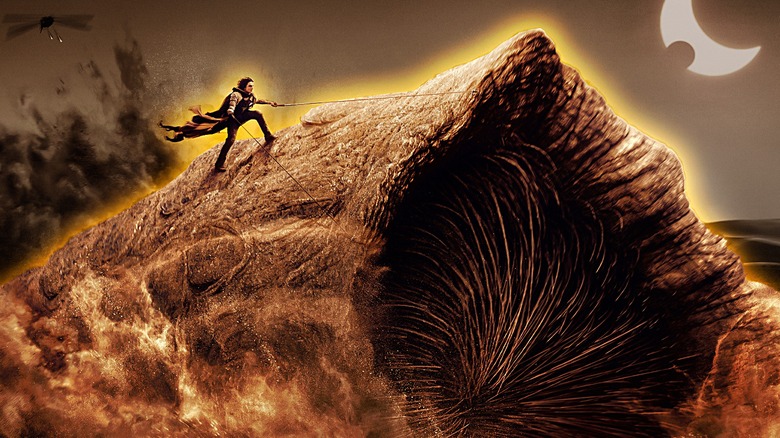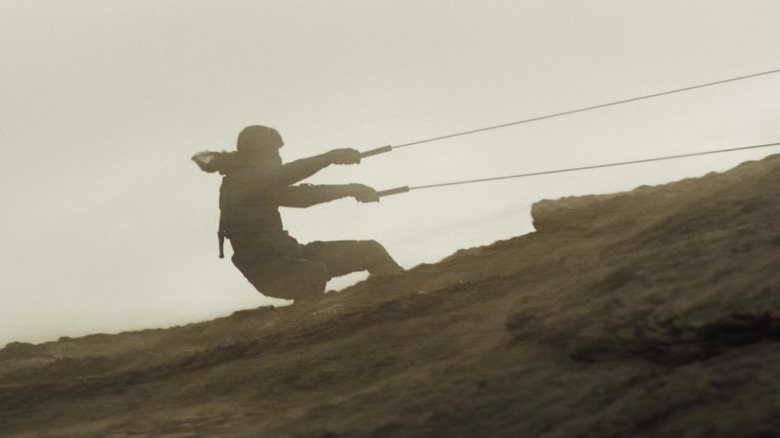Dune's Source Material Proved Worthless When It Came To Riding Sandworms
Frank Herbert's "Dune" is one of the most celebrated and influential science fiction novels of all time, a dauntingly complex narrative that tackles many different themes, ideas, and tones — with the story getting weirder and weirder as time goes on.
It is a book long considered to be impossible to adapt because of how dense it is and how fantastical many of its concepts are. Despite the simplicity of the main story, the worldbuilding is detailed and layered (and no movie adaptation has fully captured this), and bringing this world to life requires extensive use of special effects. Still, as detailed as Herbert is in many of his universe's elements, particularly the ecology of Arrakis and how that entire world works, there are many important aspects that are left surprisingly vague in the books. Whether it's the ornithopter or every other spaceship having bizarre descriptions that are immediately striking and unique yet vague enough to spark the imagination of illustrators and readers everywhere, or a key element of the book that is left rather open: wormriding.
Wormriding is an integral part of the first "Dune" book. It is the moment Paul fully becomes one of the Fremen, kickstarting his rise to power and eventual conquest of the universe. It is also the moment we fully realize what desert power is. Above all, this is just a very cool scene that seems impossible to bring to the screen. Making matters worse, it's not really described by Herbert.
"In the book, it's just written, 'and then Paul rides the worm,'" "Dune" and "Dune: Part Two" director Denis Villeneuve told Entertainment Weekly, "With no real clues of how a Fremen will actually jump onto a sandworm, this great beast with high speed and tremendous power."
VIlleneuve had to be creative in making the wormriding scene
That vagueness has allowed different filmmakers to come up with creative ways to showcase wormriding on the screen. David Lynch's 1984 movie, for all its flaws, overcomes its limited technology, and shows Paul approach the worm from the ground level, planting its hook and getting the Shai Hulud to roll over, lifting Paul up in the air. The 2000 miniseries takes its cue from this adaptation, with the Fremen using giant, long hooks. Because of its budget, this adaptation has the worm move more slowly than you'd expect from a giant creature, however.
"From the worm behavior that we had created in 'Part One,' I had to figure out how a human being could approach that: What is the Fremen technique? What do the maker hooks like? How do you use them? It required a tremendous amount of [research and development]," added Villeneuve. In the art of book for "Dune: Part Two," the making of the wormriding scene in Villeneuve's adaptation is detailed, starting with the challenges of trying to make the worm as practical as possible, resulting in a two-month shoot for a three-minute scene.
For one, the wormriding in "Dune: Part Two" is faster, more intense, and it makes the audience feel not just the enormity of the worms, but also how dangerous they are, and how skilled the Fremen are for being able to ride them. To illustrate the danger, the worm goes from moving vertically to horizontally, then back again, Villeneuve wanted to have Paul slip and be left hanging in the air off the worm's side, all while making the movement feel like a bullet train. Special rigs, gimbals and platforms were built to bring this scene to life, and the result speaks for itself.

